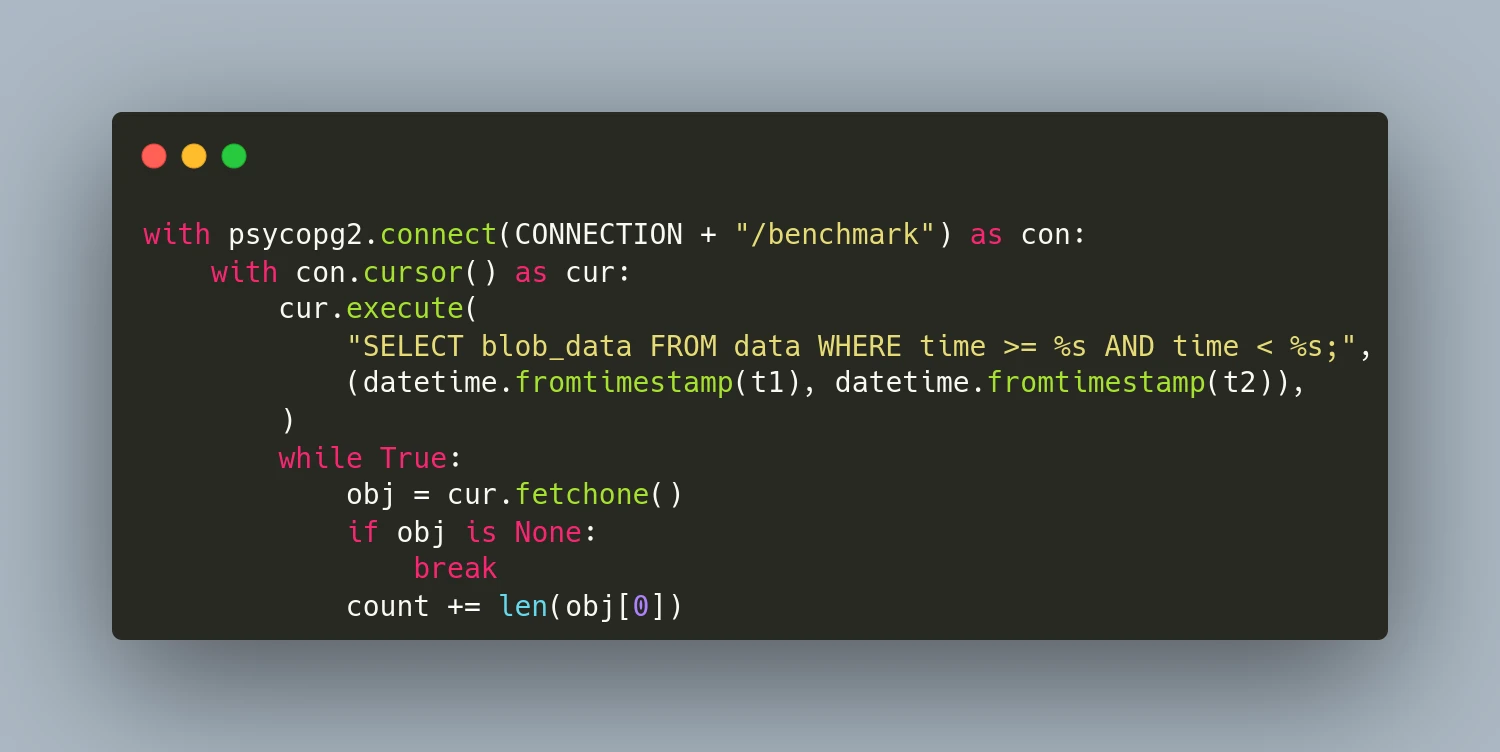Alternative to TimescaleDB for Blob Data

TimescaleDB is an open-source time-series database optimized for fast ingest and complex queries. It is engineered up from PostgreSQL and offers the power, reliability, and ease-of-use of a relational database, combined with the scalability typically seen in NoSQL systems. It is particularly suited for storing and analyzing things that happen over time, such as metrics, events, and real-time analytics.
Since TimescaleDB is based on PostgreSQL, it supports blob data and can be used to store a history of unstructured data such as images, binary sensor data, or large text documents. In this article, we will use the database as a time-series blob storage and compare its performance with ReductStore, which is designed specifically for this use case.
TimescaleDB and ReductStore both have Python Client SDKs. We'll create simple Python functions to read and write data, then compare performance with different blob sizes. To repeat these benchmarks on your own machine, use this repository.
Read/Write Blob Data With TimescaleDB
Since TimescaleDB is a part of PostgreSQL, you can use the psycopg adapter for Python to manage the database and stream the data. In this section, we initialize the TimescaleDB extension, recreate the benchmark database, and create a table for our blob data. Once the table is prepared, we write a chunk of binary data with the current time BLOB_COUNT times.
To speed up the writing process, we use the execute_values function from the psycopg2.extras module and write data in batches of BATCH_MAX_RECORDS=80 records or BATCH_MAX_SIZE=8M bytes.
import psycopg2
from psycopg2.extensions import ISOLATION_LEVEL_AUTOCOMMIT
BLOB_SIZE = 1000_000
BATCH_MAX_SIZE = 8_000_000
BATCH_MAX_RECORDS = 80
BLOB_COUNT = min(1000, 1_000_000_000 // BLOB_SIZE)
CHUNK = random.randbytes(BLOB_SIZE)
HOST = "localhost"
CONNECTION = f"postgresql://postgres:postgres@{HOST}:5432"
def setup_database():
con = psycopg2.connect(CONNECTION)
con.set_isolation_level(ISOLATION_LEVEL_AUTOCOMMIT)
cur = con.cursor()
cur.execute("CREATE EXTENSION IF NOT EXISTS timescaledb CASCADE;")
cur.execute(f"DROP DATABASE IF EXISTS benchmark")
cur.execute(f"CREATE DATABASE benchmark")
con.commit()
con.close()
def write_to_timescale():
setup_database()
with psycopg2.connect(CONNECTION + "/benchmark") as con:
with con.cursor() as cur:
cur.execute(
f"""CREATE TABLE data (
time TIMESTAMPTZ NOT NULL,
blob_data BYTEA NOT NULL);
"""
)
cur.execute("SELECT create_hypertable('data', by_range('time'))")
con.commit()
count = 0
values = []
for i in range(0, BLOB_COUNT):
values.append((datetime.now(), psycopg2.Binary(CHUNK)))
sleep(0.000001) # To avoid time collisions
count += BLOB_SIZE
if len(values) >= BATCH_MAX_RECORDS or len(values) * BLOB_SIZE >= BATCH_MAX_SIZE:
psycopg2.extras.execute_values(
cur,
"INSERT INTO data (time, blob_data) VALUES %s;",
values,
)
values = []
if len(values) > 0:
psycopg2.extras.execute_values(
cur,
"INSERT INTO data (time, blob_data) VALUES %s;",
values,
)
Now we need to create a function to read all the blobs from the table, it is quite easy, and we need only one SELECT request:
def read_from_timescale(t1, t2):
count = 0
with psycopg2.connect(CONNECTION + "/benchmark") as con:
with con.cursor() as cur:
cur.execute(
"SELECT blob_data FROM data WHERE time >= %s AND time < %s;",
(datetime.fromtimestamp(t1), datetime.fromtimestamp(t2)),
)
while True:
obj = cur.fetchone()
if obj is None:
break
count += len(obj[0])
return count
As you can see, working with Timescale is quite easy if you are familiar with any SQL database. However, you may notice that we should put the whole blob into the INSERT request. This could cause a performance problem for large blobs because we have to allocate the memory for the request string instead of sending it in chunks.
Let’s see how you can write and read data with ReductStore.
Read/Write Blob Data With ReductStore
With ReductStore, you can write and read data without using SQL requests, simply by utilizing the asynchronous API. Additionally, if you need to handle large blobs, you can stream them in chunks without loading them into memory. In this example, we also write data in batches to speed up the process for relatively small blobs.
from reduct import Client as ReductClient
async def write_to_reduct():async def write_to_reduct():
async with ReductClient(
f"http://{HOST}:8383", api_token="reductstore"
) as reduct_client:
count = 0
bucket = await reduct_client.get_bucket("benchmark")
batch = Batch()
for i in range(0, BLOB_COUNT):
batch.add(timestamp=datetime.now().timestamp(), data=CHUNK)
await asyncio.sleep(0.000001) # To avoid time collisions
count += BLOB_SIZE
if batch.size >= BATCH_MAX_SIZE or len(batch) >= BATCH_MAX_RECORDS:
await bucket.write_batch("data", batch)
batch.clear()
if len(batch) > 0:
await bucket.write_batch("data", batch)
return count
async def read_from_reduct(t1, t2):
async with ReductClient(
f"http://{HOST}:8383", api_token="reductstore"
) as reduct_client:
count = 0
bucket = await reduct_client.get_bucket("benchmark")
async for rec in bucket.query("data", t1, t2):
count += len(await rec.read_all())
return count
Benchmarks
After establishing our read/write functions, we can start writing our benchmarks.
if __name__ == "__main__":
print(f"Chunk size={BLOB_SIZE / 1000_000} Mb, count={BLOB_COUNT}")
ts = time.time()
size = write_to_timescale()
print(f"Write {size / 1000_000} Mb to TimescaleDB: {BLOB_COUNT / (time.time() - ts)} req/s")
ts_read = time.time()
size = read_from_timescale(ts, time.time())
print(f"Read {size / 1000_000} Mb from TimescaleDB: {BLOB_COUNT / (time.time() - ts_read)} req/s")
loop = asyncio.new_event_loop()
ts = time.time()
size = loop.run_until_complete(write_to_reduct())
print(f"Write {size / 1000_000} Mb to ReductStore: {BLOB_COUNT / (time.time() - ts)} req/s")
ts_read = time.time()
size = loop.run_until_complete(read_from_reduct(ts, time.time()))
print(f"Read {size / 1000_000} Mb from ReductStore: {BLOB_COUNT / (time.time() - ts_read)} req/s")
For testing purposes, we need to run the databases. This can easily be done using docker-compose:
version: "3"
services:
timescale:
image: timescale/timescaledb:latest-pg14
ports:
- "5432:5432"
environment:
POSTGRES_USER: postgres
POSTGRES_PASSWORD: postgres
volumes:
- ${PWD}/data/timescale:/var/lib/postgresql/data
reductstore:
image: reduct/store:latest
ports:
- "8383:8383"
environment:
RS_API_TOKEN: reductstore
RS_BUCKET_1_NAME: benchmark
RS_BUCKET_1_QUTA_TYPE: FIFO
RS_BUCKET_1_QUOTA_SIZE: 50TB
volumes:
- ${PWD}/data/reductstore:/data
Take note, ReductStore enables the provisioning of any resources with environment variables. In this case, we create a bucket called benchmark with a 50TB quota. Your DevOps team will appreciate it.
Let's set up and run benchmarks:
docker-compose up -d
python3 main.py
Results
The script displays results for the specified BLOB_SIZE and SIZE_COUNT. On my device, which has an NVMe drive, here are the results I obtained:
| Chunk Size | Operation | TimescaleDB, blob/s | ReductStore, blob/s | ReductStore, % |
|---|---|---|---|---|
| 1 KB | Write | 3124 | 9322 | +198% |
| Read | 40300 | 51505 | +28% | |
| 10 KB | Write | 2114 | 8395 | +297% |
| Read | 10241 | 42322 | +313% | |
| 100 KB | Write | 491 | 5026 | +924% |
| Read | 1602 | 11244 | +603% | |
| 1 MB | Write | 56 | 898 | +1604% |
| Read | 173 | 1336 | +671% |
Based on the benchmark results, ReductStore outperforms TimescaleDB in both write and read operations. The performance difference increases with the blob size, reaching up to 1604% for writing and 671% for reading 1MB blobs. This is due to the fact that ReductStore is optimized for storing and retrieving blobs, while TimescaleDB is designed for structured data and complex queries.
Other Considerations
When we choose a database for storing blob data, we should consider not only performance but also the following factors:
- Retention Policy: ReductStore provides a retention policy based on disk usage, which is crucial when the amount of data stored over time is unpredictable.
- Data Size: ReductStore is more efficient for storing large blobs, while TimescaleDB is better for small blobs.
- Querying: TimescaleDB is better for structured data and complex queries, while ReductStore is more suitable for storing and retrieving blobs with minimal overhead and latency.
- Replication: TimescaleDB replicates data across multiple nodes as exact copies, while ReductStore provides append-only replication, with the ability to filter data based on labels. This could be a part of your data reduction strategy.
Conclusions
TimescaleDB excels as a time series database and can be used to store small blobs. It's a good choice if you need to store structured data and want to avoid additional storage for blob data. However, if you have blobs larger than 10KB, ReductStore might be a better option. It offers better performance and provides a retention policy based on disk usage and conditional append-only replication for your data reduction strategy.
References
I hope this article has been helpful. If you have any questions or feedback, don’t hesitate to use the ReductStore Community forum.
